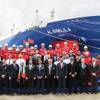By Richard Slawsky
When a pilot learning to guide ships along the Mississippi River makes a mistake and crashes into a New Orleans wharf, the only thing that ends up damaged is his ego.
That's because the mistakes happen in a ship simulator housed in an old movie theater in Covington, La.
The $1 million simulator can place a pilot on the bridge of a ship anywhere along the river between the mouth of the Mississippi and Baton Rouge. Scenes projected on the walls of the simulator, located in what once was the old DeLuxe movie theater in downtown Covington across Lake Pontchartrain from New Orleans, accurately depict every aspect of the 240 miles of waterway.
"There is not another simulator like this used in maritime training anywhere else in the world," said George Burkley, executive director of the Maritime Pilots Institute, which trains pilots using the simulator. "It is an inverted dome with 14 channels of projection. Simulators like this have been used in aviation, in a configuration where the dome is above you. In this case the dome is below you."
The Maritime Pilots Institute is a nonprofit organization formed by the Associated Branch Pilots for the Port of New Orleans, based in Metairie, La., and the New Orleans-Baton Rouge Steamship Pilot Association, based in Jefferson, La. The institute opened last year in downtown Covington and provides training and continuing education for more than 180 river pilots in the two associations.
Arnold, Md.-based Locus LLC operates the school for the pilots' associations.
"We have 30 class offerings right now," Burkley said. "We have everything from 4-hour seminars to 3-day offerings on subjects ranging from emergency shiphandling to computer aided piloting."
The Associated Branch Pilots for the Port of New Orleans is an association of professional ship pilots who guide ocean-going vessels of all sizes from the Gulf of Mexico about 22 miles upriver from the mouth of the Mississippi through Southwest Pass and the Mississippi River Gulf Outlet to Pilottown in Plaquemines Parish. The members of the New Orleans-Baton Rouge Steamship Pilots Association pilot ships on the 146-mile stretch of river between New Orleans and Baton Rouge.
The $4.5 million Maritime Pilots Institute is located in two buildings in Covington. One building is used for classroom and computer-based training while the other, the old movie theater, houses the 31-ft. long simulator.
River pilots are required to undergo professional training every one to five years. Before the institute opened, the associations had to send pilots to train in places such as Maryland or Europe. Although the associations covered the cost for the training out of their continuing education funds, travel costs came out of the pilots' own pockets.
"Opening the Maritime Pilots Institute has eliminated the need for our pilots to travel to receive training," said Capt. Michael Lorino, president of the Associated Branch Pilots of New Orleans. Lorino serves as secretary and treasurer of the institute.
According to Burkley, the institute's goal is to attract pilots from outside the two associations.
"We've gotten interest from pilot's associations in Houston and Florida," Burkley said. "In Louisiana, we have the Lake Charles Pilots (who guide ships from the Gulf of Mexico to the Port of Lake Charles) and the Crescent River Port Pilots Association, (which handles ships on the 106-mile stretch of river from Pilottown to New Orleans)."
The simulator can be programmed to duplicate any other waterway in addition to the Mississippi, Burkley said. It can also be used to train offshore supply vessel and tugboat captains, he said.
Eventually, the institute could offer training to the oil and gas industry in the Gulf of Mexico.
"The simulator is ideally suited for small boat or tug operations," Burkley said. "It's a tug bridge design. We did that so the pilots could get really high visibility for docking, but it would also be easy for tractor tug training."
In an additional bid to become a premier maritime training destination, the government of St. Tammany Parish where Covington is located is working with the institute to develop an outdoor scale model of difficult Mississippi River passages. That project is estimated to cost $11 million and is contingent upon landing state and federal grants to help finance construction.
Unlike other states, Louisiana has parishes instead of counties.
"Today, pilots have to go to France for outside training," said St. Tammany Parish President Kevin Davis. "We said, 'Wait a minute. We have the Mississippi River and all these pilots. We should be holding that international training school here in Louisiana.'."
St. Tammany Parish has acquired 200 acres near Abita Springs, La. where it plans to build two retention ponds to handle the parish's drainage. The plans call for building a 1/25 scale model of the Mississippi River passages between the two ponds.
The model also will include simulations of a Panama Canal lock and a Mississippi River lock. Pumps would simulate river currents as pilots steer vessels, also built on a 1/25th scale that handle like real ships. A training facility at Port Revel, France uses similar scale models to train pilots.
The bridge of one of the model boats would carry the same equipment and navigational systems as a regular ship. A typical model ship would be between 40 feet and 60 ft. long.
The model could also be used for homeland security drills, Davis said
The project has already received a $250,000 grant from Congress. Davis hopes the state of Louisiana and maritime interests can come up with the remainder. The facility could bring 350 jobs to the area, he said.
Future plans for the institute call for adding a second simulator. However, demand for the institute's services hasn't yet reached that level, he said.
"We have the footprint for it, but right now we have enough simulation," Burkley said. "Unless we get flooded with work our existing facility meets our needs."
However, Burkley said, that day isn't far off. "The institute has eliminated the need for pilots to travel and is also going to create a need for others to come to us," Burkley said. "The simulator can do things that can't be done elsewhere."
Subscribe for
Maritime Reporter E-News
Maritime Reporter E-News is the maritime industry's largest circulation and most authoritative ENews Service, delivered to your Email five times per week










